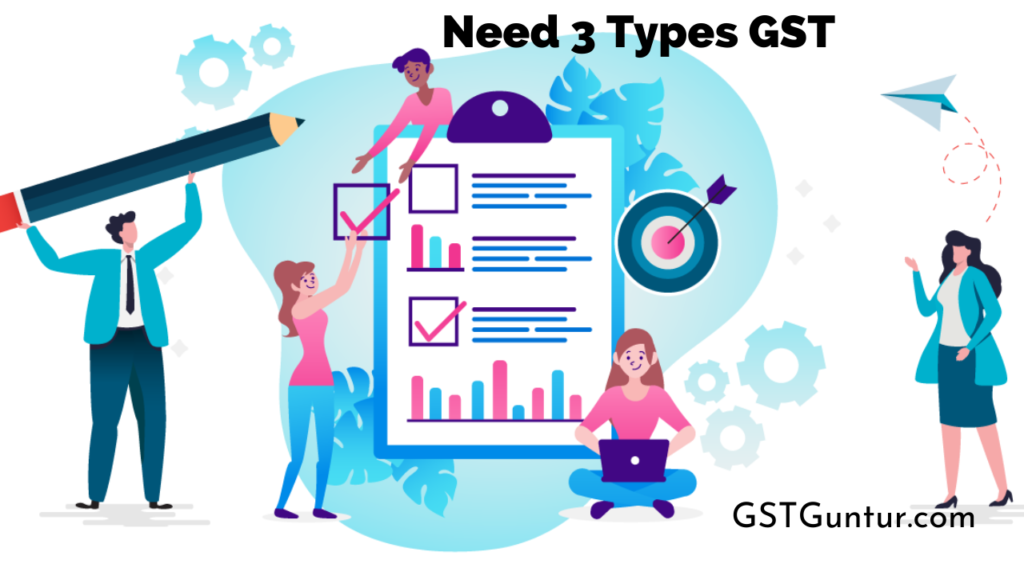Need 3 Types GST: By altering the Indian Constitution, the Goods and Services Tax (GST) went into force on July 1, 2017. Unlike in the recent past, when several taxation schemes such as Central Excise, Service Tax, State VAT, etc., GST alone has one tariff with three main components: CGST, SGST, and IGST. The central Government will levy CGST, SGST, or IGST based upon if the business transaction is intrastate or interstate under the GST statute.
- What is SGST?
- What is CGST?
- What is the IGST?
- How Will GST Credits Be Adapted Between Central Government And the states?
What is SGST?
The SGST is another of the two taxes levied by each state on dealings of goods and services. The SGST, which each country’s state government imposes, substitutes all current state tax regimes, including that of Sales Tax, Entertainment Tax, VAT, Entry Tax, etc.
The State GST or SGST, on the other hand, is taxed by the state on products and/or services acquired or supplied inside the state. Therefore, it is completely controlled by the SGST Act.
The State Government can claim the earned money under SGST.
What is CGST?
The Central Goods and Services Tax or the CGST is a tax charged on goods and services transactions conducted inside a state. The Central Government implemented CGST to substitute all other Central taxes, including State Tax, CST, SAD, and so on. Valuations for goods and services subject to CGST are formulated based on current market value.
If the GST value imposed is 18 per cent, it will be evenly split into 9 per cent CGST and 9 per cent SGST.
Note: The Union Territory Goods & Services Tax (UTGST) is the functional equivalent of the State Goods and Services Tax (SGST) and is a government-imposed on the delivery of goods and/or services in India’s Union Territories (UTs).
In Union Territories, the UTGST substitutes the SGST. As a result, in Union Territories, the UTGST will be imposed in parallel to the CGST.
What is IGST?
The IGST is imposed on interstate sales of goods and services. IGST is also applied to imported goods for transmission among the different states. When goods and services are shipped from one state to another, the IGST is imposed.
The IGST Act regulates the IGST. The Central Government is in control of tax collection under the IGST. The Central Government splits the proceeds of taxation among the several states once they have been accumulated.
How Will GST Credits Be Adapted Between Central Government And the States?
- The exporter government shall pay to the Centre the SGST credit employed in the IGST settlement. As a consequence, the exporting state will receive no taxable income.
- The Centre would send the IGST credit applied in the payment of SGST to the importing Government. This pretty much ensures that the importer’s state obtains the entire balance of SGST.
- Any revenue generated by the exporting state on such commodities is hence eventually passed to the importing state. As a direct consequence, both the central Government and the importing state automatically receive their fair proportion.
Example
Consider the following example to have a better idea.
For Rs.100, a producer (Mr X) sells items to a merchant (Mr Y) in the very same state, say West Bengal. Now, Mr Y trades to a merchant (Mr Z) in Kerala for Rs.175 and Mr Y offers the commodities to the consumer (Mr J).
Considering a CGST of 9% and an SGST of 9%.
- In the first stage, when the commodity is being sold from Mr X to Mr Y, West Bengal accumulates a tax of 100*9% = Rs. 9, and the same is applicable for the central Government.
- In the second stage, when the commodity is being sold from Mr Y to Mr Z, the central Government earns a tax of 175*18%= Rs. 31.5 minus the CGST Credit of Rs. 9 and the SGST Credit of Rs. 9, which totals Rs. 13.5.
- In stage three, when the good is being sold from Mr Z to Mr J, Kerala is liable to a tax of 300*9%= Rs. 27 minus IGST Credit of Rs. 4.5, which adds up to Rs. 22.5. The central Government receives no tax since 300*9%= Rs. 27 minus the IGST Credit of Rs. 27 adds up to Null.
- After applying all taxes, West Bengal receives a tariff of Rs 9, and the governments of Kerala and the Central Government each receive a tax of Rs. 22.5.
Now,
- The exporting state (West Bengal) would deliver to the Centre the SGST credit implemented in the IGST transaction, which is Rs. 9 (Transaction Y to Z).
- The Centre would release to the importing State (Kerala) the IGST credit applied in settlement of SGST, which corresponds to Rs. 4.5 (Transaction Z to J).
- As a result of the change, West Bengal government income is zero, Kerala’s revenue is twenty-seven rupees, and the Centre’s total revenue is twenty-seven rupees.
